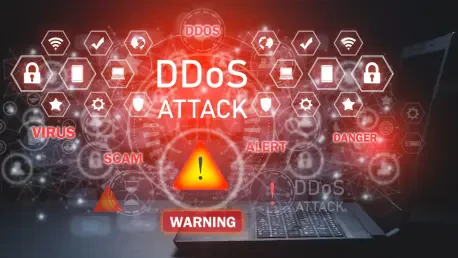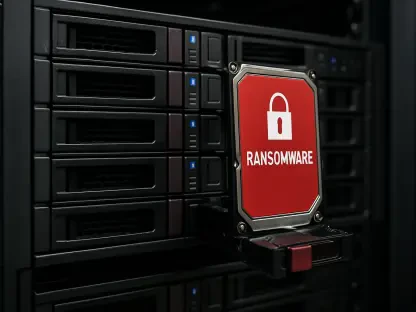The digital realm has witnessed a formidable surge in cyber threats, with DDoS attacks experiencing an unprecedented escalation. A jaw-dropping 358% increase in these disruptive events was recorded in the first quarter of the current year, according to Cloudflare’s detailed threat report. This surge translates to 20.5 million recorded incidents, marking an alarming trend that underscores the vulnerability of online services. Germany has emerged as the primary target, and industries such as gaming and telecommunications are bearing the brunt of these ferocious cyberattacks. This pattern of aggression is corroborated by a 198% increase observed in the Link11 European Cyber Report, indicating a continual expansion of these threats across the globe. Particularly concerning are hyper-volumetric assaults, exceeding 1 Tbps or 1 Bpps, setting a pressing challenge for cybersecurity specialists worldwide, with over 700 such large-scale attacks thwarted by Cloudflare’s defensive mechanisms. The increasing sophistication of cyber criminals necessitates urgent advancements in defense strategies, especially for the most affected sectors.
Gaming and Telecom Industries: Key Victims of Cyber Warfare
Impact on the Gaming Sector
The gaming industry, a sector characterized by rapid innovation and high user engagement, has found itself at the forefront of cyber warfare. The rise in DDoS attacks is not just an inconvenience but poses a serious threat to the sector’s infrastructure. Competitors are identified as principal adversaries, representing a significant 39% of the threats against gaming platforms. The digital environment hosts various kinds of perpetrators, including dissatisfied players and state-affiliated agents, who can exploit vulnerabilities with ease. This climate of hostility is exacerbated by Mirai botnet attacks, which have increased significantly, pointing to the effectiveness of botnets in executing network layer assaults. SYN floods are prominently featured in these altercations, highlighting evolving tactics by malicious entities. The frequency and intensity of these attacks necessitate a proactive defense approach, with firms urged to boost their security postures to offset potential disruptions that could ravage their operations.
Telecommunications Under Siege
Telecommunications have suffered similarly, with cyber criminals relentlessly pursuing an advantage in a realm already fraught with complexity. Just as with gaming, telecommunications face risks from elaborate cyber threats initiated by sophisticated actors. The damaging effect of massive-scale attacks is compounded by the sophistication of the mechanisms employed, including SYN floods and botnet-driven strategies. With the majority of occurrences being lower in scale—for Layer 3/4 below 1 Gbps/1 Mpps and HTTP under 1 Mrps—the consequence remains severe due to their potential to incapacitate unguarded systems. A surge of short-duration attacks, typically less than ten minutes long, showcases the cyber criminals’ strategy to leverage these brief interruptions as fundamental to their operations. Telecommunications firms must navigate this tumultuous landscape, fortifying their assets against these recurring and skilled cyber incursions, which bear the potential to cause widespread service outages and financial strife.
Evolving Threats and Strategic Defense
Hyper-Volumetric and Evolving Attack Landscapes
The emergence of hyper-volumetric attacks, characterized by their staggering data transmission rates, poses a significant threat to digital infrastructure. These assaults are not only grand in scale but are meticulously crafted to breach even robust security architectures, demonstrating the resourcefulness of hackers in deploying sophisticated tactics. Cloudflare’s successful mitigation of over 700 hyper-volumetric incidents epitomizes the extent of these challenges. Furthermore, attack source analysis reveals hotspots in regions such as Hong Kong, Indonesia, and Argentina. This geographical diversity underlines the expansive nature of threats, requiring global vigilance and response coordination. It is evident that defending against these evolving threats demands sophisticated strategies, advanced technology, and comprehensive protection frameworks to ensure resilience and safeguard critical assets across affected areas.
New Amplification Methods and Future Implications
Emerging attack strategies like those involving CLDAP and ESP amplification are gaining traction, pointing to significant future vulnerabilities. These methods exploit specific protocol weaknesses to achieve overwhelming effects, demonstrating cybercriminals’ adaptability in consolidating their offensive tactics. The significant growth rates of these amplification methods demand urgent attention, with organizations and experts advocating for heightened awareness and robust, continuous mitigation measures. The anticipation of increased prevalence of these attacks confirms the need for in-depth investment in cybersecurity technologies and relentless infrastructural vigilance. As tactics evolve, the cybersecurity landscape must adapt swiftly, reinforcing defenses to outmaneuver these high-stake threats and minimize the risk of grave digital disruption. Organizations globally must prepare to enhance their strategies and collaborate on innovative solutions to mitigate the risks posed by looming threats.
Defending the Digital Frontier
The digital landscape is increasingly vulnerable as cyber threats, particularly DDoS attacks, have surged dramatically. This year, Cloudflare’s comprehensive threat report documented a staggering 358% rise in these disruptive events during the first quarter, totaling 20.5 million incidents—a trend highlighting the precariousness of online services. Germany has been identified as the most targeted nation, with industries like gaming and telecommunications facing significant challenges from these relentless cyberattacks. Echoing this alarming pattern, the Link11 European Cyber Report reveals a 198% increase in attacks, underscoring their global proliferation. Hyper-volumetric assaults, exceeding 1 Tbps or 1 Bpps, pose an urgent challenge to cybersecurity experts around the world, exemplified by Cloudflare’s successful defense against over 700 major attacks. The rise in cyber criminal sophistication demands immediate innovation in defense strategies, particularly for sectors most under siege.









